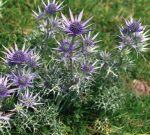 Native to Morocco, Lebanon, Turkey, France, and Spain, this rosette-forming herbaceous perennial is a member of the parsley family, Apiaceae, that also includes dill, celery, and Queen Anne’s lace. It grows 1-2′ tall from a taproot and has stiff well branched stems bearing palmately divided gray-green leaves that are up to 2 inches long and have silvery white veins. From mid summer into fall, terminal flowerheads appear. They are up to 1″ across and 3/4″ long, consists of a cone-shaped structure bearing tiny blue-green to silver-blue flowers, and are subtended by long silvery bracts up to 2″ long. The plants are tolerant of lean soil and drought and are a good choice for a xeriscape, border, and rock, cottage, and cutting gardens. In addition, the flower heads add both texture and form to fresh and dried arrangements. The genus name, Eryngium, is from the Greek word eryngo that refers to the prickly or spiny nature of the genus. The specific epithet, bourgatii, honors Dr. Bourgat, an 18th century French physician and plant collector.
Native to Morocco, Lebanon, Turkey, France, and Spain, this rosette-forming herbaceous perennial is a member of the parsley family, Apiaceae, that also includes dill, celery, and Queen Anne’s lace. It grows 1-2′ tall from a taproot and has stiff well branched stems bearing palmately divided gray-green leaves that are up to 2 inches long and have silvery white veins. From mid summer into fall, terminal flowerheads appear. They are up to 1″ across and 3/4″ long, consists of a cone-shaped structure bearing tiny blue-green to silver-blue flowers, and are subtended by long silvery bracts up to 2″ long. The plants are tolerant of lean soil and drought and are a good choice for a xeriscape, border, and rock, cottage, and cutting gardens. In addition, the flower heads add both texture and form to fresh and dried arrangements. The genus name, Eryngium, is from the Greek word eryngo that refers to the prickly or spiny nature of the genus. The specific epithet, bourgatii, honors Dr. Bourgat, an 18th century French physician and plant collector.
Type: Herbaceous perennial
Bloom: Flower heads with tiny blue-green to silver-blue flowers, subtended by long silvery white bracts; from mid summer into fall
Size: 1-2’H x 1-2′ W
Light: Full sun; tolerates some shade but best color is in full sun (with cool temperatures)
Soil: Average to lean, dry, well-drained; tolerates drought, lean soil and saline conditions
Hardiness: Zones 3-8
Care: Low maintenance
Pests and Diseases: None of significance
Propagation: Seed, root cuttings
Companion Plants: Achillea ‘Moonshine’ and ‘Terracotta’, Liatris spicata, Astrantia major ‘Roma’
Outstanding Selections:
‘Oxford Blue’
“Picos Amethyst’
‘Pico Blue’
Photo Credit: Wikimedia Commons
.